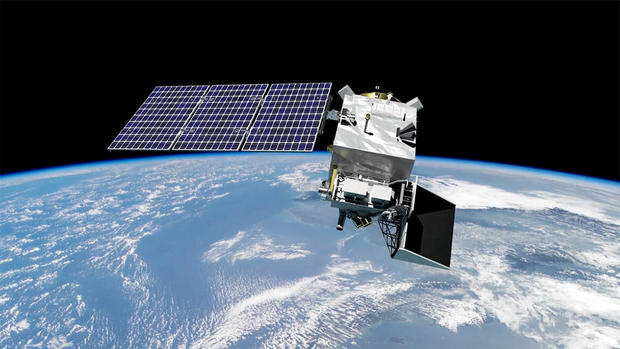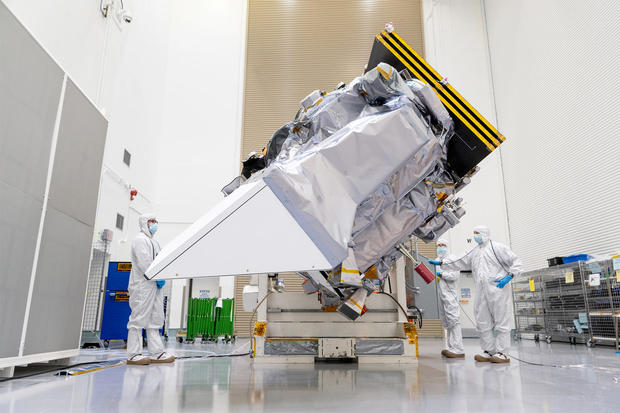SpaceX launched an environmental research satellite for NASA early Thursday, a nearly $1 billion spacecraft that survived multiple cancellation threats and is now poised to shed new light on climate change and the complex interplay of heat-trapping carbon, aerosols and sea life on global scales.
The Plankton, Aerosol, Cloud, ocean Ecosystem mission -- PACE -- "will dramatically advance our understanding of the relationship between aerosols and clouds, and the global energy balance," said Karen St. Germain, director of NASA's Earth sciences division. "This is one of the biggest sources of uncertainty in our ability to model the climate."

She said PACE is "going to teach us about the oceans in the same way that Webb (the James Webb Space Telescope) is teaching us about the cosmos." And that includes "a tremendous amount about ocean biology."
"This is going to really center around understanding phytoplankton, these very small (organisms) that live in the ocean, that are at the foundation of life in our oceans in general."
Oceans cover 70 percent of the planet's surface, she added, "and yet the oceans are one of the least well understood parts of the Earth system. PACE is going to profoundly advance our understanding of how the oceans work and how life in the oceans is related to life on land."
Running two days late because of high winds at the launch site, the mission began at 1:33 a.m. EST Thursday when the nine first stage engines powering a SpaceX Falcon 9 rocket roared to life, lighting up the deep overnight sky across Cape Canaveral.

Putting on a spectacular show, the Falcon 9 arced away on a southerly trajectory over the Atlantic Ocean just off the eastern coast of Florida as it climbed toward a 420-mile-high orbit around Earth's poles.
Polar orbits enable Earth-observation satellites, weather stations and reconnaissance platforms to view the entire planet as it rotates below. Tuesday's liftoff marked the first polar launch from the East Coast for the U.S. government since 1960, when a rocket went awry and debris fell on Cold War-era Cuba and killed a cow.
Since then, NASA and the Pentagon have launched polar payloads from Vandenberg Space Force Base in California.
But SpaceX successfully launched a Falcon 9 to polar orbit from Florida in August 2020 and has since launched multiple payloads on such southerly trajectories. With PACE, NASA agreed government safety requirements had been met.
Trajectories and launch sites aside, the PACE mission had a rocky road to the launch pad. The Trump administration made multiple attempts to cancel the project, in part to devote more resources to NASA's accelerated moon program. But Congress did not go along, and funding was added back to the agency's budget each time.
"I'm not going to dive into policy or politics, but it's been a really remarkable journey," said Jeremy Werdell, PACE project scientist. He credited support from the science community, NASA and the public for keeping the program on track and boosting morale throughout.

The PACE satellite, built at NASA's Goddard Spaceflight Center in Greenbelt, Md., is equipped with three instruments: a hyper-spectral color camera and two light-analyzing polarimeters, one providing wide-angle views of polarized light reflected from land, sea and the atmosphere below and the other providing a narrow-angle view.
"It's a three-instrument payload and frankly, the technology really just operates like your eyes do," Werdell said. "We are looking for interactions of sunlight -- photons, quanta -- with the atmosphere, ocean and land. Whatever those photons touch, they get absorbed or they get scattered, and then the instrument sees what they are."
Despite its name, PACE "is not an ocean mission. It's not an atmosphere mission. It's not a land mission. It's an all-of-those-things mission," Werdell said.
"And that is so incredibly important, because you can't understand one without understanding the other. ... This is a mission that we don't know what we're going to learn about. And that is so deeply exciting."
PACE is expected to provide high-precision data allowing researchers to fine-tune computer models, giving policy makers more accurate information about ongoing trends and long-term threats. It will also provide real-time measurements of aerosol movement through the atmosphere, plankton health and carbon transport.
"Understanding how ocean life interacts with the atmosphere and the global climate is one of the secrets of the universe right here at home," said NASA Associate Administrator Jim Free.
"Aerosols that cycle through the ocean and atmosphere are a factor in how clouds form and how weather systems behave. But exactly how that process works is a scientific mystery. Unraveling it is one big goal of the PACE mission."
Kate Calvin, NASA's chief scientist and senior climate advisor, said the last 10 years have been the hottest since record keeping began, reflecting an overall warming trend driven in large part by greenhouse gases like carbon dioxide.
"As carbon dioxide is released, some of it is absorbed by land, some of it is absorbed by the ocean, and some stays in the atmosphere trapping heat," she said. "Greenhouse gases aren't the only factors affecting temperature, there's also these tiny particles called aerosols that reflect or absorb sunlight and also affect cloud formation.
"PACE is going to provide more information on oceans and atmosphere, including providing new ways to study how the ocean and atmosphere exchange carbon. It's also going to give us information on aerosols, information that helps us understand long-term climate."
The PACE satellite, its Falcon 9 rocket and mission operations are costing NASA $948 million. After extensive tests and instrument calibration, science observations are expected to begin in about two months.
While the design life calls for a three-year mission, project officials are optimistic the spacecraft will operate for 10 years or more when all is said and done.
Space & Astronomy
More SpaceX launches NASA satellite designed to shed new light on climate change
SpaceX launches NASA satellite designed to shed new light on climate change  Commercial crew heads for home after extended space station visit
Commercial crew heads for home after extended space station visit  A total solar eclipse will darken U.S. skies in April 2024
A total solar eclipse will darken U.S. skies in April 2024  Watch: Asteroid NASA calls "potentially hazardous" about to zoom past Earth
Watch: Asteroid NASA calls "potentially hazardous" about to zoom past Earth  Cygnus cargo ship attached to space station after smooth rendezvous More William Harwood Twitter
Cygnus cargo ship attached to space station after smooth rendezvous More William Harwood Twitter 
 Special Counsel Robert Hur Hits Biden For 'Significantly Limited' Memory
Special Counsel Robert Hur Hits Biden For 'Significantly Limited' Memory Wall St fecha em alta com impulso de bancos e grandes empresas de tecnologia
Wall St fecha em alta com impulso de bancos e grandes empresas de tecnologia Analistas apontam alta na demanda global de café no primeiro trimestre
Analistas apontam alta na demanda global de café no primeiro trimestre Importação de milho passa de 85 mil toneladas em maio e já é 36% maior do...
Importação de milho passa de 85 mil toneladas em maio e já é 36% maior do... Ramagem deveria se afastar de Comissão do Congresso, diz Marinho
Ramagem deveria se afastar de Comissão do Congresso, diz Marinho




